What is Colombian elite shungite?
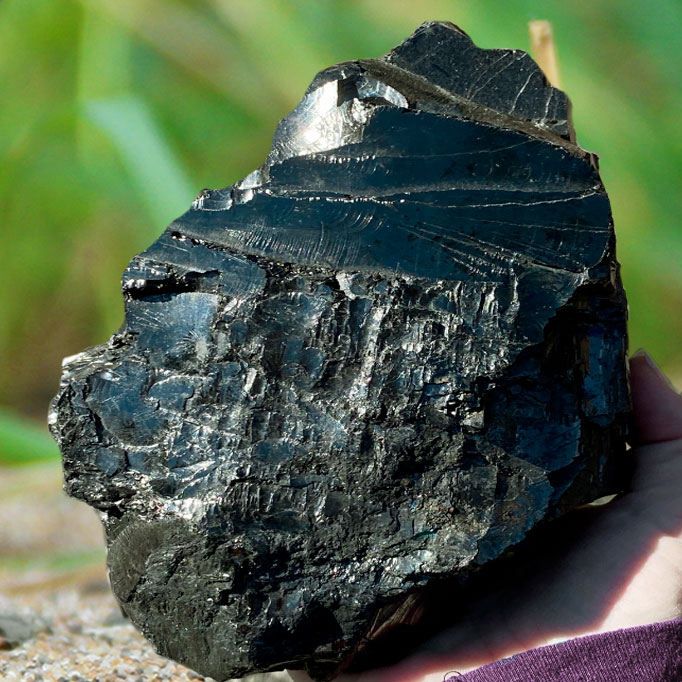
We received a massage from our customers about such a new phenomenon on the Internet as Colombian elite shungite from Colombia, South America. These buyers asked us why the sellers of this stone write that Colombian elite shungite is very similar to your real Karelian elite shungite of the first type? We will try to sort out this issue, can it be that Colombian elite shungite is fake?
Our shungite store asked why those sellers write that “Colombian elite shungite” has the same amount of carbon as the unique elite shungite from Karelia. But they say they found this first type “Colombian elite shungite” in Colombia, South America. At the same time, everyone, in their photographs, this “Colombian elite shungite” is very similar to the elite shungite from Karelia.
Of course, we were very surprised by this information, since there is a well-established opinion in the scientific community that the only place with deposits of shungite of the first type with a carbon content of up to 99% exists only in Karelia, Russia.
How to find this Colombian elite shungite in Colombia, South America?

We decided to find where this so-called Colombian elite shungite is mined. We started looking for any mention of Colombia elite shungite in the shungite scientific literature. But during the search, we used the words shungite or higher anthraxolite. These terms are official scientific geological names of “elite shungite” of first type from Karelia.
The fact is that the term Elite shungite or Noble shungite is not quite a scientific term. Therefore, you will not find any good publications about elite shungite. Why is that?
First, let’s say that the name “shungite” itself comes from the name of the village Shunga in Karelia (Russia), where this mineral was found. The fact is that in Karelia there are several types of shungite, depending on the carbon content, they are divided into types or varieties. And the rarest variety of Karelian shungite contains up to 99% of carbons. This kind of Karelian shungite is called the first type shungite.
To avoid confusion and for simplicity, the term elite shungite or noble shungite somehow took root. Therefore, the name elite and noble is just a marketing designation of the first type of shungite with a high carbon content from Karelia.
And in the scientific literature, Karelian elite shungite of the first type is called the highest anthraxolite. It is also called brilliant shungite of the first type. This is Karelian elite shungite or anthraxolite with a carbon content of up to 99%.
Thus, elite shungite of the first type from Karelia has a different scientific name – the highest anthraxolite.
But Karelian shungite stands out among the higher anthraxolites in that real fullerenes were found only in it.
Let’s find the highest anthraxolite in Colombia.
Well, we have shown our readers how to search for scientific information on shungite of the first type with a carbon content of up to 99%. Therefore, we began to look for scientific sources with information about this Colombian elite shungite in conjunction with the word superior anthraxolite. First we searched for: Higher anthraxolite Colombia, then we complicated the queries. However, this did not bring us results.
And after all, we could not find any publications on the manifestations of higher anthraxolites in Colombia. You can try it yourself, maybe you will be more successful in finding higher anthraxolite in Colombia. Please write to us if you can do it.
That is, we did not find any mention of higher anthraxolite deposits (that is, in the context of our investigation of the Colombian Elite Shungite fake).
The Emerald Deposits of Muzo, Colombia.
Later, we nevertheless learned about the mention of the term higher anthraxolite in connection with Colombia in the work of Filippov, M. M. “Anthraxolites” / M. M. Filippov, 2013. In it, he talks about manifestations of higher anthraxolites in the area in the emerald mines of Muzo in Colombia, South America.
However, on the Internet and in scientific books, we have not been able to find any higher anthraxolites in the emerald mines of Muzo in Colombia. And again, if you find such photos from the field and mentions in the scientific community, then write to us.
Maybe in the Emerald deposit of Muzo mine there are manifestations of higher anthraxolites, but they are so small and isolated that no one is studying and mentioning them.
Shiny anthracite coal in Muzo mine, Colombia
However, we found something else in Colombia that looks like elite shungite. In Colombia, at the Muzo mine, various minerals can be found among emerald veins, including shiny ancient coal – anthracite.
In particular, in this text about the emerald mine of Muzo there is such a mention:
Anthracite. — Small fragments of impure anthracitic to graphitic carbon are found in joints in the emerald formation.
Judging by the quote and the scarcity of information, the amount of anthracite in the emerald veins was scanty, in the form of small rare inclusions.
In short, anthracite is a ancient coal, but it is not the highest anthraxolite. Initially, researchers called elite shungite anthracite because of its strong luster, until they did more research and realized that they are fundamentally different.
Anthracite from Pennsylvania.
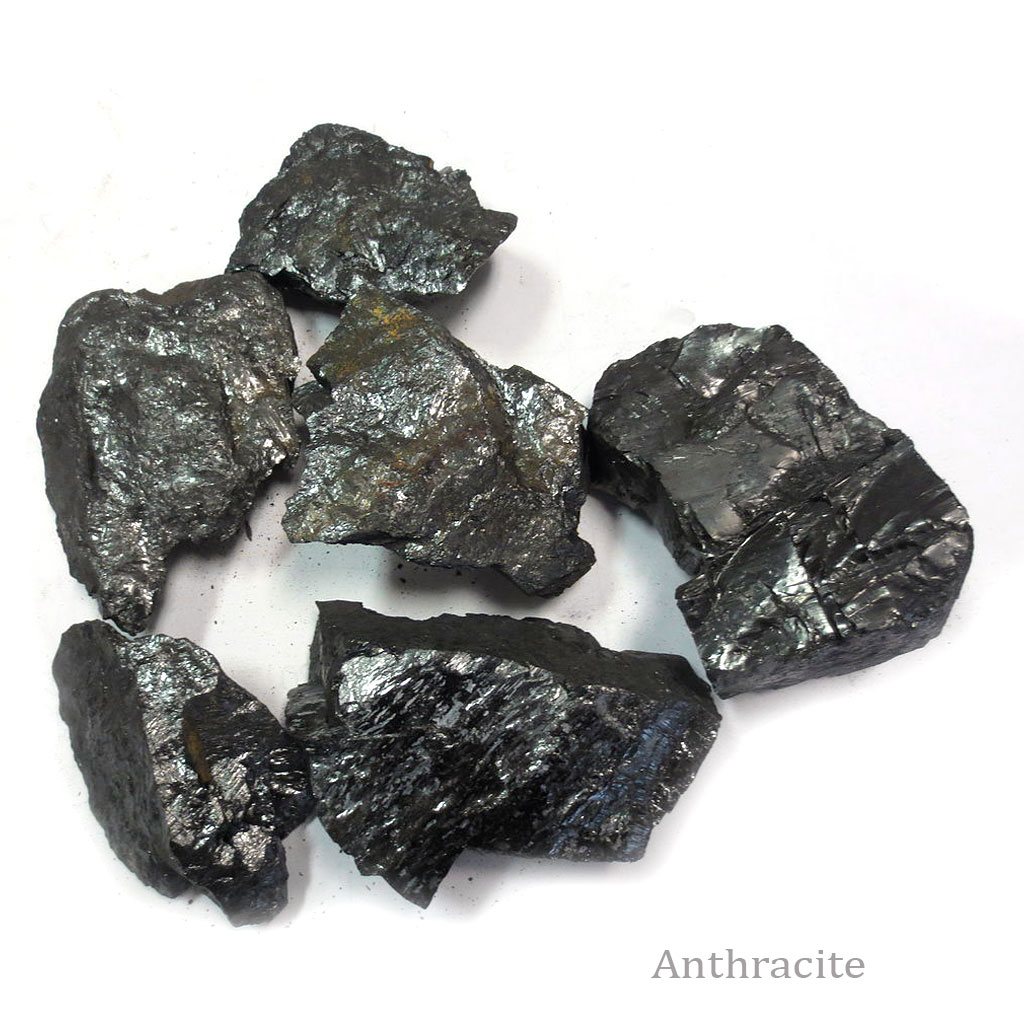
Anthracite itself is a fossil coal, its deposits are huge all over the world. Therefore, most likely, no one will take the risk and will not go to Colombia for anthracite.
Therefore, for the US market, for example, an anthracite deposit in Pennsylvania is quite suitable at hand.
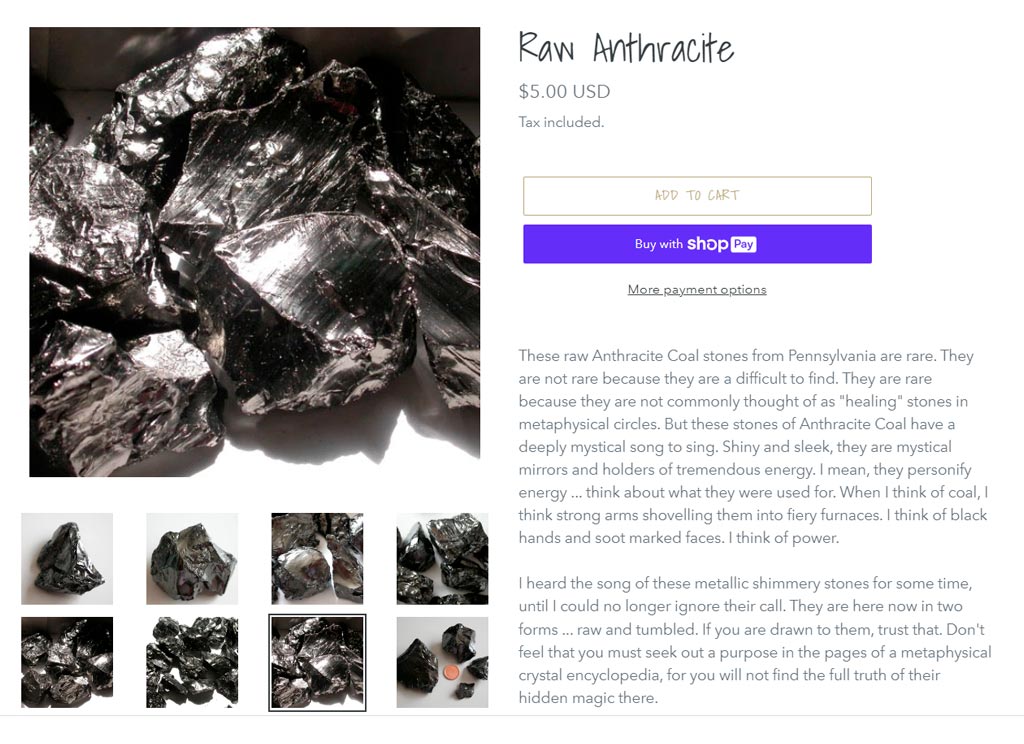
Anthracite is the oldest fossil coal, coal of the highest degree of coalification (metamorphism). The best grade of coal, characterized by black color, strong luster, high calorific value. It has a high density of organic matter (1300-1800 kg/m³) and some small electrical conductivity. Hardness on a mineralogical scale 2.0-2.5.
Anthracite contains the highest amount of carbon among all coals. There are no fullerenes in the composition of anthracites.

Anthracite deposits are estimated at 6080 million tons in China, 6870 million tons in Russia, 710 million tons in South Africa, 200 million tons in Spain and 60 million tons in the United States and so on.
Anthracite is used as a fuel in the energy sector, in transport and in everyday life, as well as in some technological processes.
What is the difference between higher anthraxolite (or elite shungite) and anthracite?
- Elite shungite is a mineral, but anthracite is fossil coal.
- The electrical conductivity of elite shungite (or highest anthraxolite) is much higher than that of anthracite. That is, the electrical conductivity of the highest anthraxolite (shungite of the first type) is tens and hundreds of thousands of times higher than that of anthracite.
- Higher anthraxolite burns poorly and cracks when heated. Anthracite burns quickly, without smoke and flame, with high heat transfer, does not sinter.
- The highest anthraxolite (or elite shungite of the first type) from Karelia can’t be from Colombia. There is no geological evidence for the existence of such deposits.
- Karelian shungite contains in its composition consists of a special amorphous form of carbon up to 99%, in which fullerenes are present. Due to the special form of carbon and fullerenes in the composition, shungite has protective properties against EMF radiation.
- Anthracite is 91-98% carbon, but the net amount of fixed carbon in it is from 73 to 80% (after removal of all impurities). The bound carbon of anthracite differs from the free (amorphous) carbon of shungite in that it is chemically bonded to other elements. And in bound carbon, fullerene molecules, which are in shungite, cannot exist. And Anthracite does not have the unique properties that elite shungite from Karelia has.
- The age of elite shungite is very ancient, it is Precambrian, that is, more than 2 billion years ago. The oldest deposits of anthracite are of Neogene and Cretaceous age and have been found in the Rocky Mountains of Canada (between 2 and 140 million years).
- Shungite is denser, therefore, with the same size, elite shungite will be heavier than anthracite. Bulk density of elite shungite is 1,7-2,0 gr/cm³. Bulk density of anthracite is 1,3-1,8 gr/cm³.
- They have different chemical composition.
Higher anthraxolite or elite shungite of 1 type.

As we wrote above, the strict scientific name of Karelian shungite is the highest anthraxolite.
In the classification of researcher-geologist V. A. Uspensky et al. (Uspensky et al., 1964): in the class of anthraxolites, the lowest, middle, and highest anthraxolites are distinguished according to the degree of transformation.
Higher anthraxolites (or Elite Shungite) have the following characteristics:
- metallic or diamond shine;
- conchoidal fracture;
- density 1.7–2.0 g/cm3;
- they are electrically conductive;
- the content of C is up to 99%, H is about 1%, they usually contain heteroelements (N, S, O);
- they crack when heated;
- The molecular structure of higher anthraxolites and their composition are not constant, therefore they are included in the class of mineraloids. Anthraxolites have an anisotropy of optical and other physical properties, their reflectivity (in air) is in the range of 11–14.2%, they belong to diamagnets.
The highest anthraxolite (shungite of the first type) has up to 99% carbon in its composition. This carbon has a special amorphous form. At the same time, only the highest anthraxolite from Karelia – Karelian shungite of the first type contains fullerenes in its composition.
Real elite shungite first type ( higher anthraxolite ) only from Karelia.
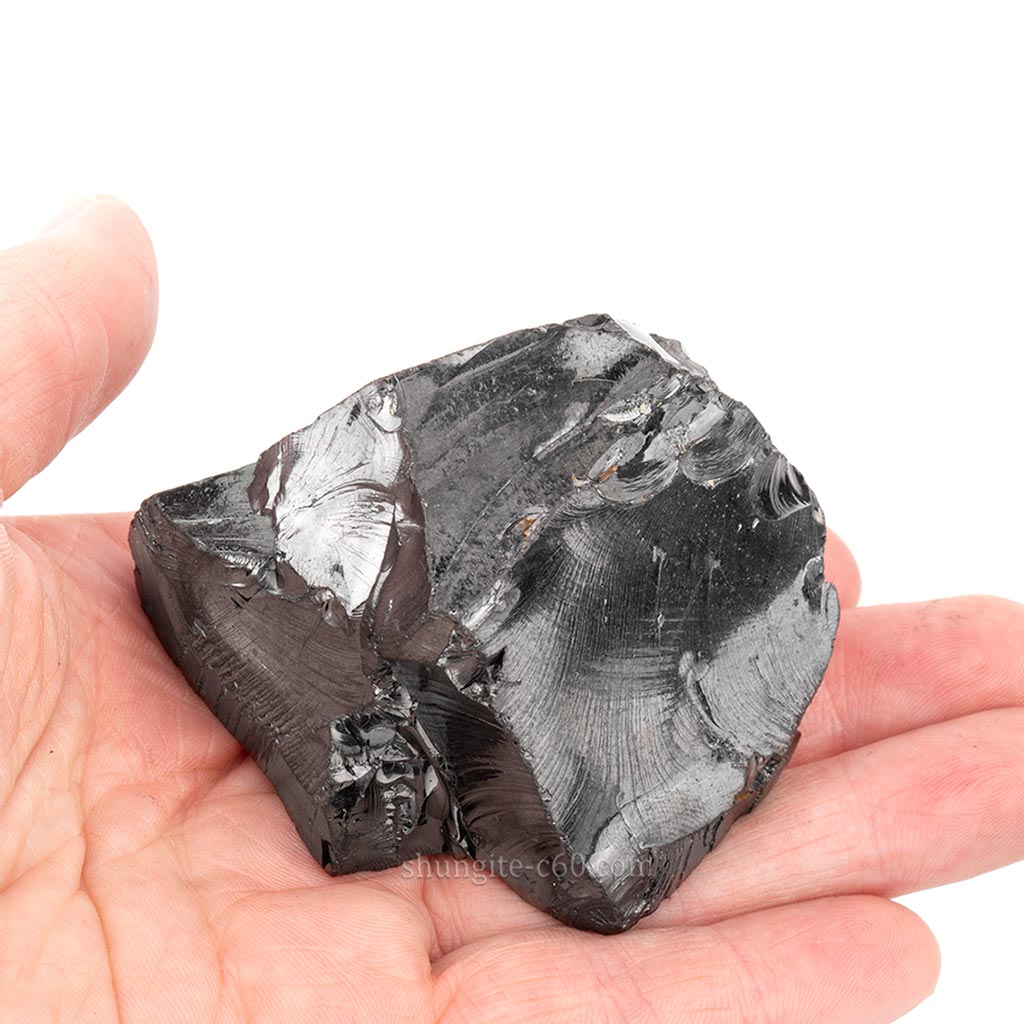
Genuine Mineral Shungite or it is also called elite shungite of the first type was found only in Karelia, in the village of Shunga, in honor of Shunga, scientists called this brilliant mineral Shungite. Nowhere else on the planet is there such a mineral, only in Karelia. This is a scientifically proven fact, and it is also the official scientific name of this rare stone – shungite. And the term “Elite” is just a marketing name for this shungite of the first type, which means the fact that the carbon content is from 75 to 99%.
In this article, you can learn more about the between difference shungite and other rocks.
Why are photographs allegedly of Colombian elite shungite similar to elite shungite from Karelia?
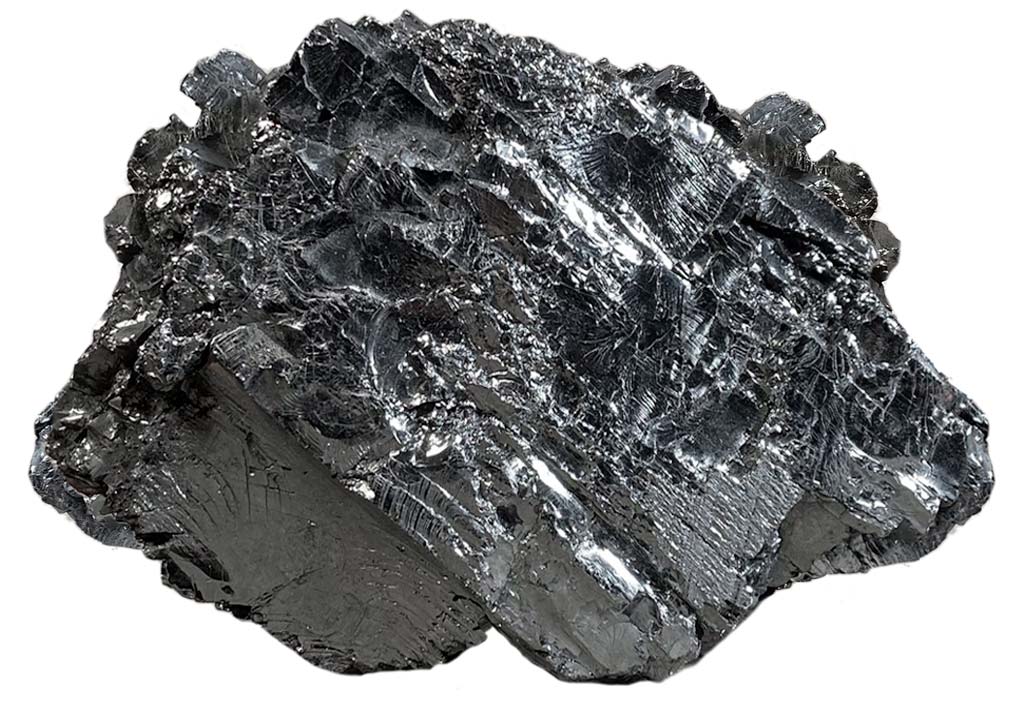
The fact is that real elite shungite from Karelia is easily confused by an ordinary person with a photograph of anthracite and other minerals. As you can see from the photos.

But even more similar to elite shungite is natural asphaltite – Gilsonite!
Yes, perhaps, the appearance of Gilsonite very much resembles elite shungite from Karelia. The name of natural bitumen Gilsonite has been patented by a natural asphaltite company in the United States since the 1860s. So in Uintah County in Utah, USA in the 1880s, a grade of natural asphaltite Gilsonite was patented by the name of the industrialist S. Gilson, who promoted this ore on the market. However, this natural Gilsonite asphalt also has the place name Uintahite, Uintah.
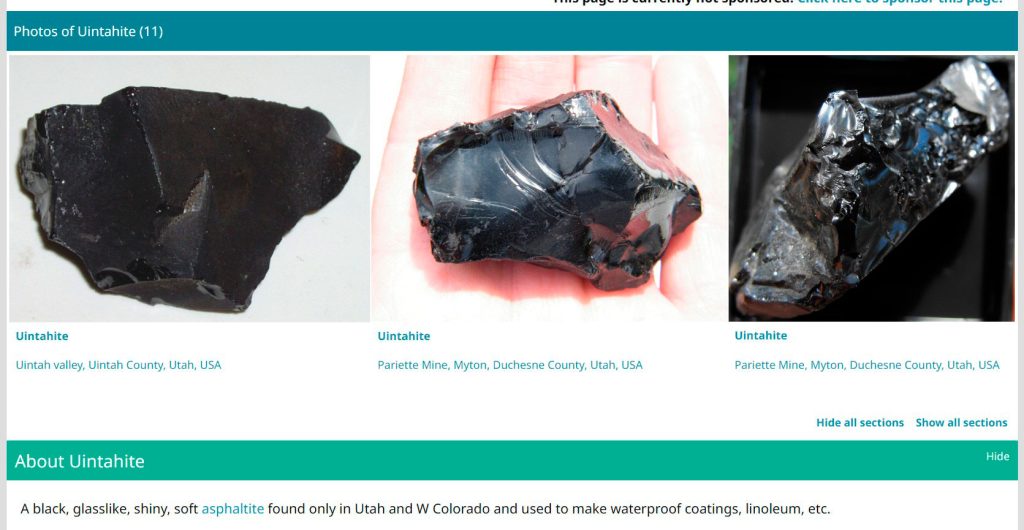
Gilsonite is a natural resinous hydrocarbon, which includes macromolecular compounds. They are formed during the oxidation of oil under the influence of oxygen dissolved in water. The main deposits are located in the United States in the state of Utah. There are also deposits in Colombia.
In addition, there are Gilsonite deposits in other places. These are Iran, China, Argentina, Venezuela, Syria, Jordan, France and Azerbaijan. The production of Gilsonite is millions of tons per year.
It looks like obsidian, and as we understand it, it is very similar in appearance to elite shungite from Karelia. But Gilsonite is not shungite in any way. The similarities between them only end with the fact that they are very similar in appearance.
Gilsonite is very brittle, so it is easy to grind into a powder that will have a dark brown color.

How does the so-called elite Colombian shungite differ from the real elite shungite from Karelia?
Indeed, it turns out that at first unprofessional glance it turns out the so-called Colombian Elite shungite and higher anthraxolite (Karelian elite shungite of the first type) are similar? Yes, they look very similar in the photo! However, despite this, do not despair.
Remember, that this deceptive similarity works if you do not have a geological examination and the chemical composition of the sample on hand. After all, the chemical composition of elite shungite of the first type from Karelia will be very different from the chemical composition of Gilsonote or Anthracite.
In addition, there are big differences between Gilsonite and Shungite of the first type from Karelia, which force geologists to attribute them to completely different groups. These are age and chemical composition and physical properties, line color, solubility in organic solvents. All these parameters of asphaltene Gilsonite and shungite of the first type from Karelia are strikingly different.
So we summarize that, we have not found evidence that there are deposits of higher anthraxolites (elite shungite) in Colombia. Furthermore, we found only a mention of anthracite coal in the emerald mines of Muzo, Colombia.
But the most important, we did not find evidence of the existence of such a geological term as Colombian elite shungite.
What do they say about the composition of this “Colombian Elite Shungite”?
Some people just write 99% carbon without presenting any evidence. But even such a statement does not make the sample an elite shungite.
The chemical composition is not mentioned in these studies. We will only have information from the description that the sellers of Colombian elite shungite provide on their website. Thus, the most important thing is what we will rely on. The thing is, you can read the following:
“It was tested at the Gemological Institute of America and confirmed”.

Note that we are only talking about the amount of carbon in the sample. The chemical composition is not mentioned in these studies.
Who researched the Colombian Elite Shungite?
For example, you can find such information about testing a sample from the Gemological Institute of America. After all, they found as much as 93.8% of carbon there. Do not forget that on the leaflet of this study it is called Colombian elite shungite first type.

An interesting fact is that a sample with a non-existent geological name was delivered for testing. What were these people researching in that lab, what was that sample? We could not find evidence of the discovery of such a mineral as elite shungite from Colombia.
However, we draw your attention to the fact that we do not see any method, how research was conducted in that laboratory, what equipment they used. They also didn’t do a chemical analysis of the sample. Overall, this report does not look convincing to us.
We will not say anything about the ordinary employees of the laboratory that examined this sample. After all, in fact, officially there is no such mineral with that name. Perhaps in that laboratory they were simply provided with a paid service.
What is the result of the study of a non-existent sample?

But on what basis an unknown sample protects against EMF radiation, we did not understand, since we found no evidence of this.
As we have already understood, even a piece of anthracite coal can contain a lot of carbon up to 98%. However, its bound carbon differs in structure from amorphous carbon in elite shungite from Karelia with fullerenes.
All this is similar to the fact that someone enjoys the fame of a real elite shungite of the first type from Karelia.
After all, shungite became known all over the world primarily thanks to this silvery variety from Karelia. After all, only elite shungite from Karelia from the only deposit in the world has become so famous due to the fact that real fullerenes were found in its composition. At the same time, fullerenes on Earth have so far been found only in Karelian shungite.
Also, it was in Karelian shungite that protective properties were found, thanks to which shungite can adsorb and protect against harmful EMF waves. The ability of shungite from Karelia to absorb and scatter EMF waves is a scientifically proven fact.
You can look at real elite shungite of the first type from Karelia in this section of rare samples.
In addition to photographs of the sample, you must have evidence.

After all, in fact, we will not be able to say with accuracy from a photograph what kind of mineral is depicted there. Therefore, in most cases, evidence is needed of where this mineral came from, where it was mined, and whether there is geological confirmation of its authenticity.
At the same time, these sellers do not provide any reliable evidence of the origin of Colombian Elite Shungite, is Colombian Elite Shungite fake? Because such a mineral does not exist on Earth. What proof of authenticity can they provide?
After all, first of all, it is important to understand that laboratory tests should be done on real samples of elite shungite from Karelia. We have them. After all, we did a real geological laboratory study of our samples of elite shungite of the first type from Karelia. We ordered our research at the Institute of Geology of the Republic of Karelia. This is the oldest scientific geological institute, it has a whole “Laboratory of geology and technology of schungites of the Department of Mineral Resources”. Only Shungite is studied there. Almost everyone in this institute knows about shungite, because Karelian shungite is the real pride of Karelia.
And those who pass off unknown stones as elite shungite do not have any documentary studies of their samples. And where can they come from? After all, this is a non-existent fake stone from the mythical mines in Colombia.
So what is this Colombian elite shungite?
Thus, we have built our article in accordance with the logic of the fictitious name Colombian elite shungite. We came to the conclusion that a possible insignificant mention of Colombia in connection with the highest anthraxolite has no real confirmation.
But we also stumbled upon anthracite on the way, very similar in appearance to Karelian shungite of the first type. The question of the similarity of the so-called Colombian shungite with anthracite remains open and burning. Therefore, we also carefully study it.
Next, we studied the offers on the market called Colombian shungite and its photos. We also found similar offers from those who do not hide and sell real anthracite.
And we also found another important candidate – Gilsonite, which may be hiding under the name Colombian elite shungite. This gilsonite is a natural asphaltite and is very similar in appearance to elite shungite. Gilsonite may be from Colombia and also from Utah in the USA.
We also found out that in the scientific community there is no such term as Colombian elite shungite. This is a fictitious name, Colombian elite shungite is a fake.
Anthracite is what is passed off as elite shungite, which is found only in Karelia.
So, recently the risk of acquiring a fake instead of a real elite shungite has significantly increased. This is due to the fact that Anthracite looks like elite shungite. Moreover, the situation is complicated by the fact that anthracite has some electrical conductivity. However, the electrical conductivity of anthracite is many times worse than that of elite shungite.
After all, in the USA there are large old reserves of anthracite from the NE Pennsylvania region of the USA. This is a well-known anthracite coal region in the USA. Moreover, there are anthracite mines in Colombia in the Santander deposit. And this anthracite is very similar in appearance to elite shungite.
Checking the authenticity of “Elite shungite from Colombia” using an electrical conductivity test.
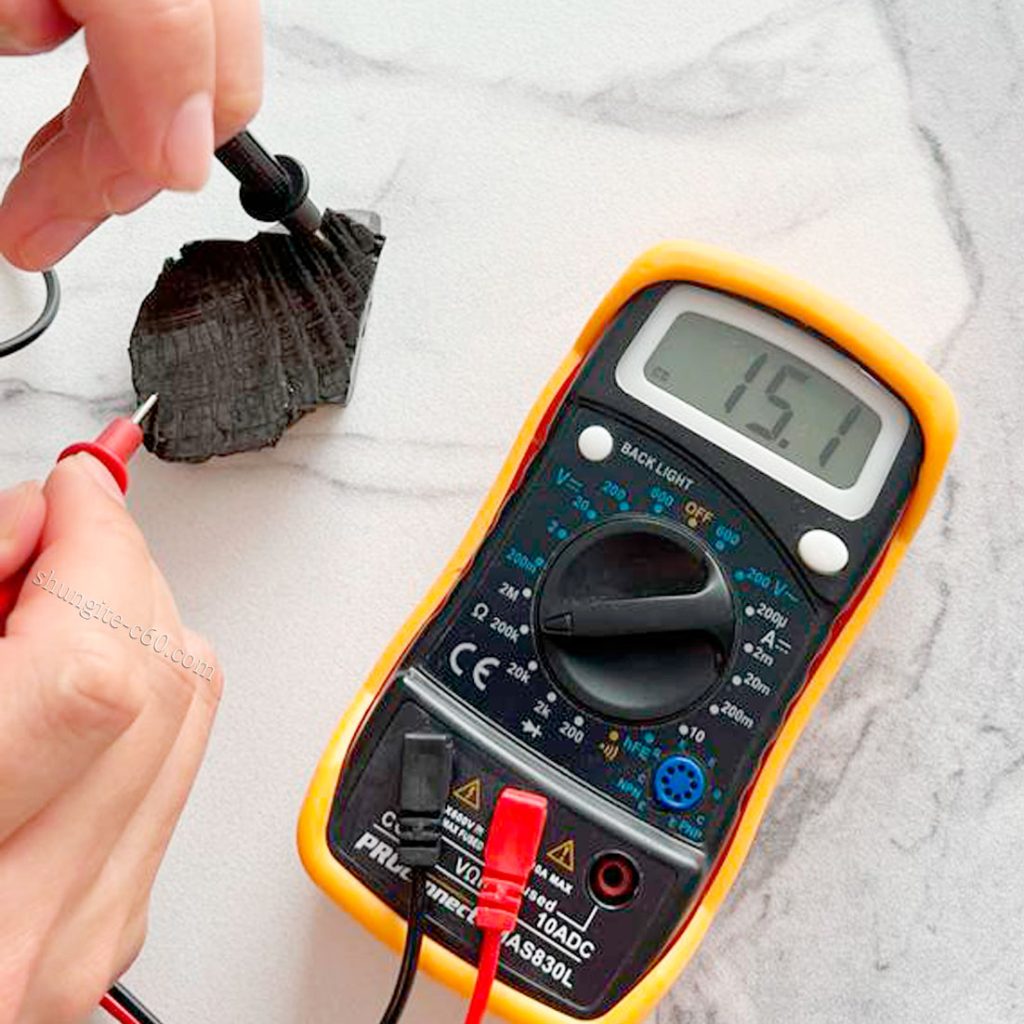
As a result, we nevertheless purchased a sample of this so-called Colombian elite shungite or Raquerite ourselves.
We saw that indeed, at first glance, outwardly it is very similar to elite shungite. However, nevertheless, this sample turned out to be a little dimmer than elite shungite and lighter in structure.
However, the most important and the only test that can be used to determine whether this sample is elite shungite or not is a test for electrical conductivity. After all, the ability to conduct electricity well is the main distinguishing feature of shungite. That is, electrical conductivity is the most important sign of the authenticity of shungite.
We did this test using a multimeter. And this sample did not pass it!
We measured the resistance to electric current, which for this sample of Colombian shungite starts at 3,000,000 ohms. Given that the electrical resistance of real elite shungite should be almost zero.
On the video you will see the first measurement of a metal fork, then real elite shungite. At the same time, you will see that the metal and elite shungite have zero current resistance.
And you will see in this video the measurement of a sample of the so-called Colombian elite shunigit in the form of the largest piece. You will notice the smallest number 13.8 and 15, you can also see numbers in the region of one hundred, these are 165, 189 and others.
How to understand the numbers on this multimeter?
Please note that the measurement range on the multimeter instrument is 200K. This means that this instrument has a sensitivity of 200,000 ohms (the letter K stands for the power of 103).
That is, if we see, for example, the number 15 on a multimeter, then we must multiply it by 200,000 to get the exact resistance. 15 * 200,000 = 3,000,000 ohms.
That is, this sample, which is sold under the name “Elite shungite from Colombia” or “Raquerite” is not an elite shungite. After all, it has a high resistance to current – it is at least 3 million ohms, you must agree, because this figure is much more than the zero resistance of genuine shungite.
We calculate the resistivity of a sample of the so-called Colombian shungite.
So, we measured the resistance of this sample of the so-called Colombian elite shungite. It amounted to a value from 15∙200K to 189∙200K ohms. That is, the resistance of the sample is from 3,000,000 ohms to 37,800,000 ohms. And now we need to calculate its resistivity.
Formula for calculating resistivity:
ρ = (R ∙ S) ÷ L,
ρ – electrical resistivity, Ohm∙m (Ω⋅m); R – electrical resistance, Ohm (Ω); L – conductor length m, (meter); S – conductor cross-sectional area, m2 .
R1 = 15 ∙200K=15∙200∙103 = 15*200 000 = 3 000 000 Ohm
R2 = 189 ∙200K=189∙200∙103 = 189*200 000 = 37 800 000 Ohm.
The length of the sample of the so-called Colombian elite shungite was approximately 4.8 cm = 0,0048 m.
Calculate the cross-sectional area of this sample: S = 2.5 cm ∙ 5.5 cm ∙ 5 cm = 0.0025 m∙ 0.0055 m ∙ 0.005 m = 0.00000006875 m2 or 68.75 ∙ 10-9 m2.
ρ1 = (3 000 000 Ohm ∙ 0.00000006875 m2 ) ÷ 0,0048 = 42.9 ≈ 43 Ohm∙m.
Further, calculate the resistivity for the larger resistance value that we saw on the multimeter:
ρ2 = (37 800 000 Ohm ∙ 0.00000006875 m2 ) ÷ 0,0048 = 541,4 ≈ 541 Ohm∙m.
Thus, we roughly calculated the resistivity for a sample of the so-called Colombian elite shungite. This value was approximately from 42 to 541 Ohm∙m or 4.2 ∙ 101 to 5.41 ∙ 102 Ohm∙m.
The resistivity of a fake shungite sample corresponds to that of anthracite.
Thus, above we roughly calculated the resistivity for a sample of the so-called Colombian elite shungite. This value was approximately from 42 to 541 Ohm∙m or 4.2 ∙ 101 to 5.41 ∙ 102 Ohm∙m.
For example, the resistivity for anthracite is 1 ∙ 10-2 to 1 ∙ 102 Ohm∙m or from 0,01 to 1000 Ohm∙m.
The specific resistance for real elite shungite is 2.18 ∙ 10-4 Ohm∙m or 0.00218 Ohm∙m.
Please note that the resistivity of real elite shungite is a value very close to zero (0.00218 Ohm∙m). But for a sample of supposedly Colombian shungite, the resistivity from about 42 to 473 Ohm∙m is in the range of anthracite.
As a result, we can say that the resistivity of this sample of the so-called elite shungite from Colombia is greater than that of real elite shungite by a value from 19 266 to 248 165 times.
We calculated it like this: 42 ÷ 0.00218 = 19 266 and 541 ÷ 0.00218 = 248 165.
Thus, judging by the resistivity, which is inversely proportional to the electrical conductivity, this sample of Colombian Elite Shungite fake, has some kind of low electrical conductivity, approximately the same as that of anthracite.
In addition, when measuring the specific gravity of a sample of fake shungite in the article about “shungite fake“, we found out that it also corresponds to anthracite – this is 1,44 gr/cm3. After all, anthracite coal has a much lighter structure than shungite.
What is the result.
As a result, most of all examples of fakes of elite shungite we found among rather large samples at an ultra-low price. Usually they are sold under the name Colombian Elite Shungite or Raquerite.
In order not to buy a fake, first of all, pay attention to the name of the mineral, because there is no such mineral on Earth as elite Colombian shungite or or Raquerite.
As a result, so-called Colombian elite shungite is some kind of brand, someone invented it. And in this sense, too, Colombian Elite Shungite fake.
This non-existent and so-called elite shungite from Colombia has nothing to do with the real elite shungite of the first type from Karelia. Since the only known large deposit of the elite shungite mineral of the first type exists only in one place in the world – this is Karelia, Russia. According to its physical characteristics, this Colombian Elite Shungite fake is coal anthracite.
 Dutch
Dutch English
English French
French German
German Italian
Italian Spanish
Spanish Swedish
Swedish